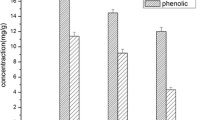Abstract
The antioxidant activities of various organic solvent extracts from Artemisia capillaris herba were investigated. The results indicated that methanol extracts of Artemisia capillaris herba possessed higher contents of phenolic compounds and showed stronger antioxidant activities than other organic solvent extracts. The methanol extracts of Artemisia capillaris herba exhibited 91.1% of the scavenging effect at a dose of 200 ppm on the 1,1-diphenyl-2-picrylhydrazyl (DPPH) radical and showed strong antioxidant activity in the Β-carotene bleaching system. The methanol extracts were separated into three fractions by preparative HPLC using a Wakopak C18 reversed-phase column. After purifing with preparative HPLC, AC-1, 2 and 3 compounds were obtained. Their structures were established as chlorogenic acid (AC-1), 3,5-dicaffeoylquinic acid (AC-2) and 3,4-dicaffeoylquinic acid (AC-3) on the basis of UV-vis spectral, HPLC and FAB-MS data. The scavenging effect of purified compounds on DPPH radical equaled that of tert-butyl-4-hydroxytoluene (BHT) and α-tocopherol at a dose of 10 ppm.
Similar content being viewed by others
References
Thompson JW, Sherwin ER (1966) Investigation of antioxidants for polyunsaturated edible oils. J Am Oil Chem Soc 43: 683–686.
Marx JL (1987) Oxygen free radicals linked to many diseases. Science 235: 529–530.
Addis PB, Warner GJ (1991) The Potential Gerbal Aspects of Lipid Oxidation Products in Food. London: Taylor & Francis, pp 77–119.
Yamahara J, Matsuda H, Sawada T, Mibu H, Fujimura H (1982) Biologically active principles of crude drugs. Pharmacological evaluation of Artemisiae capillaris Flos (1). Yakugaku Zasshi 102: 285–291.
Hikino H (1985) Antihepatotoxic activity of crude drugs. Yakugaku Zasshi 105: 109–118.
Namba T, Hattori M, Takehara Y, Tsunezuka M, Tomimori T, Kizu H, Miyaichi Y (1983) A flavone from Artemisia capillaris. Phytochemistry 22: 1057–1058.
Komiya T, Tsukui M, Oshio H (1975) Capillarisin, a constituent from Artemisiae capillaris Herba. Chem Pharm Bull 23: 1387–1388.
Komiya T, Tsukui M, Oshio H (1976) Studies on ‘Inchinko’. Capillarisin, a new choleretic substance. Yakugaku Zasshi 96: 841–854.
Tsushida T, Suzuki M, Kurogi M (1994) Evaluation of antioxidant activity of veget-able extracts and determination of some active compounds. Nippon Shokuhin Kogyo Gakkaishi 41: 611–618.
AOAC (1984) Official Methods of Analysis, 14 ed. Washington, DC: Association of Official Analytical Chemists.
Brand-Williams W, Cuvelier ME, Berset C (1995) Use of a free radical method to evaluate antioxidant activity. Food Sci Technol 28: 25–30.
Yen GC, Duh PD (1994) Scavenging effect of methanolic extracts of peanut hulls on free-radical and active oxygen species. J Agr Food Chem 42: 629–632.
Miller NJ (1971) A simplified method for the evaluation of antioxidants. J Am Oil Chem Soc 48: 91.
Gutfinger T (1981) Polyphenols in olive oils. J Am Oil Chem Soc 58: 966–968.
Ramarathnam N, Osawa T, Namiki M, Tashiro T (1986) Studies on the relationship between antioxidative activity of rice hull and germination ability of rice seeds. J Sci Food Agric 37: 719–726.
Yen GC, Duh PD, Tsai CL (1993) Relationship between antioxidant ability and maturity of peanut hulls. J Agric Food Chem 41: 67–70.
Yen GC, Chen HY (1995) Antioxidant activity of various tea extracts in relation to their antimutagenicity. J Agric Food Chem 43: 27–32.
Shimada K, Fujikawa K, Yahara K, Nakamura T (1992) Antioxidative properties of xanthan on the autoxidation of soybean oil in cyclodextrin. J Agric Food Chem 40: 945–948.
Sherwin ER (1978) Oxidation and antioxidants in fat and oil processing. J Am Oil Chem Soc 55: 809–814.
Dziezak JD (1986) Antioxidants. Food Technol 40: 94–102.
Horman I, Badoud R, Ammann W (1984) Food-related applications of one-and two-dimensional high-resolution proton nuclear magnetic resonance: structure and conformation of cynarin. J Agric Food Chem 32: 538–540.
Hayase F, Kato H (1984) Antioxidative components of sweet potatoes. J Nutr Sci Vitaminol 30: 37–46.
Oleszek W, Amiot MJ, Aubert SY (1994) Identification of some phenolics in pear fruit. J Agric Food Chem 42: 1261–1265.
Maruta Y, Kawabata J, Niki R (1995) Antioxidative caffeoylquinic acid derivatives in the roots of burdock (Arctium lappa L.). J Agric Food Chem 43: 2592–2595.
Author information
Authors and Affiliations
Rights and permissions
About this article
Cite this article
Seo, HC., Suzuki, M., Ohnishi-Kameyama, M. et al. Extraction and identification of antioxidant components from Artemisia capillaris herba . Plant Foods Hum Nutr 58, 1–12 (2003). https://doi.org/10.1023/B:QUAL.0000040355.60922.08
Issue Date:
DOI: https://doi.org/10.1023/B:QUAL.0000040355.60922.08




